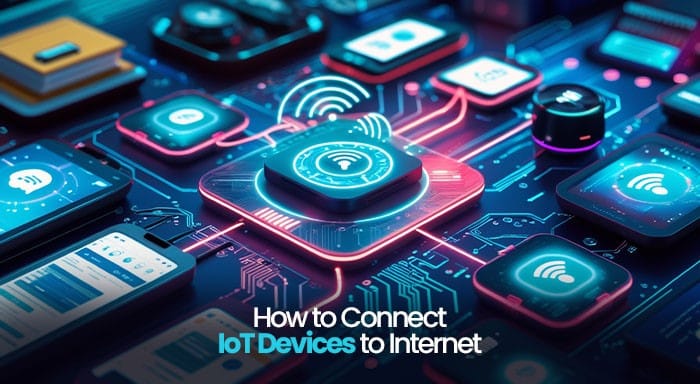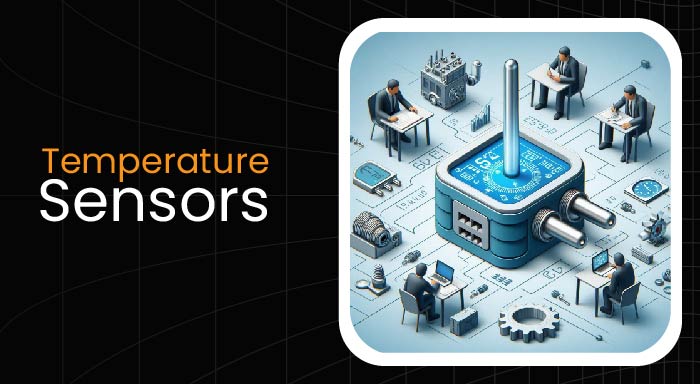The world of Internet of Things is fascinating and frankly invaluable to us now. It connects a vast array of objects ranging from wearables, daily appliances, and transportation systems to custom applications in corporate. Through this smart interconnection, IoT transforms the way we interact with our surroundings, work, and live our lives. IoT is not only revolutionizing various sectors but also creating a future where objects will be more connected and efficient.
When we discuss IoT, one of the main things we need to focus on is how these IoT devices interact with one another and are connected to the internet. There are numerous technologies and methods utilized to create these connections, each having its own benefits and applications. Let us, in this blog, study the methods through which these IoT devices are connected. You will learn how to connect IoT devices to internet.
How to Connect IoT Devices to the Internet?
An IoT environment leverages numerous methods to establish a strong connection over the internet. The methods utilized depend on multiple factors like power consumption, range, data transfer speed, and security needs. Let us take a closer look at some of the prevalent methods used to establish a connection to the Internet-
Wired Connection:
One of the easiest ways IoT devices can connect to the Internet is via a wired connection. This method involves directly connecting the IoT device to an internet modem or a network router via an ethernet cable. This method is helpful for a closed environment and ensures a secure and reliable connection. However, this method might not be a right fit for the devices that move a lot or are in remote locations.
Wireless Communications:
The reason wireless communication is mostly preferred in IoT environments is because ofthe flexibility and convenience it offers. Wireless Fidelity (or Wi-Fi) is the most prevalent wireless protocol utilized for IoT systems. Wi-Fi ensures devices are strongly connected to the local network, empowering them to use internet resources and ensure data exchange. Wi-Fi ensures a fine balance between range, speed, and power consumption. This makes the device ideal for a particular environment or area.
Cellular Network Communications
Just as smartphones connect to the internet, IoT systems can access the internet through cellular networks. This method leverages an in-built SIM card or an outside cellular module to ensure a robust connection. Cellular connectivity is beneficial when IoT devices are used in mobile environments or remote areas. This is because accessibility to Wi-Fi networks in such environments might be limited. However, it can consume more and can be expensive compared to other connection methods.
Bluetooth Connection:
Bluetooth is a wireless technology utilized for short-range data exchange. It can help two IoT devices connect to one another and exchange information. In our daily life, Bluetooth is often used as connectivity technology for nearby devices. However, IoT developers can use Bluetooth technology to connect an IoT device to a gateway or smartphone that is itself connected to the internet. In IoT environments, Bluetooth can be majorly utilized for short-range applications such as wearables, smart home devices, and beacons.
Zigbee Connection:
Zigbee is a communication protocol of IoT specifically designed for low-power IoT devices. It operates on the 2.4 GHZ frequency and enables devices to communicate with one another via a mesh network. Zigbee entails features like low latency, long battery life, and compatibility with a wide range of devices. This makes the protocol right for applications like lighting control, home automation, and intelligent energy management.
Z-Wave Communication:
Z-Wave is yet another wireless protocol that empowers IoT devices to seamlessly connect and interact with one another. Just like Zigbee, it works on 2.4 GHZ frequency and leverages a mesh network topology. Z-wave is popular for its range, reliability, and interoperability. This makes the protocol an ideal choice for applications like security systems and home automation.
NFC Connection:
NFC, i.e., Near Field Communication is a type of wireless technology for short-range applications. It enables two devices to create a connection by bringing them in proximity. NFC is utilized commonly for contactless payments and transfer of data between smartphones. It can also be utilized by IoT devices to ensure fast and secure connection to the internet.
Thread Connection:
Thread connection is a type of wireless protocol designed specifically for IoT devices. It works particularly within smart home environments. It provides secure, low-power, and reliable connectivity for devices that form a part of a complete thread network. Thread also operates on the 2.4 GHZ frequency band and utilizes IPv6 addressing.
This allows all the devices connected to the thread network to have direct accessibility to the internet and communicate with one another, basically forming a mesh network. The topology of mesh network makes sure that the data can be routed through numerous devices. This extends the range and enhances reliability of the network.
LoRaWAN:
It is a type of LPWAN network protocol, i.e., Low-power wide area network. Purpose-built for IoT environment, it optimizes capacity, battery life, cost, and range. This makes the protocol ideal for connecting various devices over long distances with less energy consumption. It utilizes LoRa radio modulation to facilitate an efficient wireless environment, connecting end-node systems to network gateways and mainly the internet.
Conclusion
The above blog explained how to connect IoT devices to the internet and discussed a few methods through which efficient connection can be established. Choosing among the methods basically depends on requirements and application. By making use of this technology, IoT devices can ensure smooth communication, collect information, and give crucial insights for numerous applications and industries.



